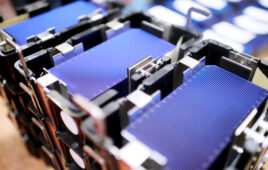With bifacial modules becoming more commonplace, mounting systems have had to quickly adjust to a new design. Since the gains from bifacial modules can be especially high with tracking systems, manufacturers are adapting their systems to meet demand.
Most single-axis trackers can support framed and frameless bifacial modules with the right attachments, but traditionally designed trackers may have support rails or foundation poles that contribute shading to the backside of the module, thus limiting the energy gains from the bifacial cells.
Soltec has specially formulated its SF7 Bifacial tracker to be taller (to capture more bifacial gains), and modules are positioned in two-up portrait-mode to avoid backside shading losses. Arctech Solar’s SkySmart tracking system is also specially designed for bifacial modules and uses four- or six-clamp mounting to reduce backside shading.
NEXTracker’s NX Horizon single-axis tracker features PV panels portrait-mounted on low-profile shared rails, generous clearance between the module back surface and round torque tubes, plus avoidance of foundation pier and array bearing placement underneath the PV panels. These design elements help maximize energy production for bifacial panels. NEXTracker also provides site-specific design recommendations for customers using bifacial technology, which includes optimizing array elevation and ground coverage ratio.
“In addition, NX Horizon’s wider tracking range further improves bifacial performance,” said NEXTracker CMO Mike Mehawich. “With 120° of rotational range, the backside of the module can capture reflected irradiance over a longer period of time each day.”
Array Technologies vice president of engineering Mark Preston said the company plans to release a bifacial tracker before the end of 2018. Array Technologies is analyzing different design elements to adapt to bifacial modules, including switching up the tracking algorithm.
“Pointing [panels] at the sun isn’t necessarily maximum production for bifacial systems,” Preston said.
One other thing that may be overlooked with bifacial tracking systems is that both sides of the modules have to be cleaned regularly to optimize production.
“NEXTracker’s independent rows make it easier to [clean] since we can turn adjacent rows face-to-face or back-to-back with ease, and there is no linkage blocking the rows,” Mehawich said.
Bifacial module manufacturer Trina Solar has done extensive testing of bifacial modules and found that when attached to a tracker and on a white-painted surface, bifacial modules provide 33.2% more energy than traditional monofacial modules. Trina found that bifacial modules on a tracker over sand have a 24.42% energy gain.
Trackers that can support bifacial modules’ full energy potential are very valuable in ensuring quick ROI. Mehawich with NEXTracker predicts that a large amount of the market will be pairing bifacial modules with single-axis trackers soon.
“Bifacial is best on a single-axis tracker, and this will take a large share of the tracker market,” he said. “With the wider ground cover ratio provided by the tracker and with spare sunlight on the ground, the end of the day provides the highest [gains with bifacial].”






To authenticate your article, is there any PVsyst report that gives up to 30% more energy than mono facial modules?
GTM Research had similar findings: https://www.greentechmedia.com/articles/read/bifacial-plus-tracking-boosts-solar-energy-yield-by-27-percent#gs.Wj9SAwM
Kelly, the GTM article you cite was misleading. The 27% gain was an apple and orange comparison of a bifacial-equipped tracking system against a same-sized monofacial FIXED-TILT system. The bifacial boost was only half that much.